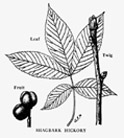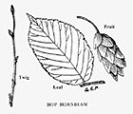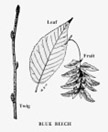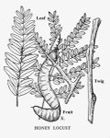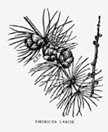SHAGBARK HICKORY
scalybark hickory
Carya ovata (Miller) Koch
|
| Shagbark hickory is the best known and most valuable of the hickories in this state. It is common in deep, moist soils throughout New York though rare in the higher Catskills and Adirondacks, and is not reported from the pine barrens of Long Island. In the forest it is a tall straight-branched tree but in open fields and along hedgerows where it often grows it usually forks near the ground into stout ascending limbs. The wood is very heavy, tough, elastic, close-grained, and is used chiefly for handles, vehicles, agricultural implements, and fuel. The fruit is important for wildlife. |
| Bark - light gray in color, smooth and seamy, becoming shaggy with age and peeling off into long strips which are loose at both ends and attached in the middle, thus giving rise to the name "shagbark hickory."Twigs - covered with numerous light dots, extremely tough and pliable, reddish brown to gray in color. Winter buds - large, ovate, blunt-pointed, with papery, dark brown, loose bud scales, the outer scales much darker, persistent through the winter; terminal bud usually more than 1/2 inch long. Leaves - alternate compound, 8 to 14 inches long, with 5 to 7 leaflets, the 3 upper ones being by far the largest. Fruit - a smooth, white, 4-angled nut, enclosed in a thick, round husk that splits into 4 sections as the nut falls after heavy autumn frosts. Kernel - large, sweet. Distinguishing features - large terminal bud; 5 to 7 leaflets, outer 3 much larger; bark peeling in long plates. |
